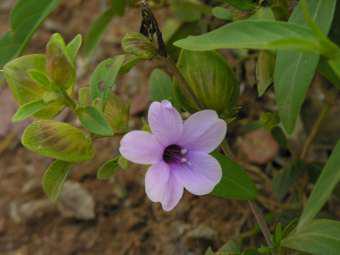Barleria mackenii
Barleria mackenii Hook.f.
Family: Acanthaceae
Common names: Mr McKen's barleria (Eng.): bosviooltjie (Afr.)
Introduction
Barleria mackenii is a medium-sized shrub with mauve, tubular flowers which appear from February to June.

Description
Description
Barleria mackenii is an unarmed evergreen shrub growing up to 0.75 m under tropical and subtropical conditions, and up to 0.50 m under colder conditions.The leaves are narrowly ovate, greyish to olive-green. Young branches are densely covered with short, soft, white waxy hairs. The flowers are large, mauve and with a dark purple throat. The bracts (modified leaves), two per flower, are very prominent. The plant flowers from February to June. The fruit is a small, sharply pointed exploding capsule.
Conservation Status
Status
According to the Red Data List of southern African plants (Hilton-Taylor 1996), the conservation status of Barleria mackenii is Not Threatened (nt). taxa which do not qualify for Conservation Dependent, but which are close to qualifying for Vulnerable.
Distribution and habitat
Distribution description
Barleria mackenii has been recorded in the summer-rainfall areas of KwaZulu-Natal , Mpumalanga and the Limpopo Province of South Africa, as well as being found in Namibia , Zimbabwe and Botswana, from altitudes between 610-1850 m. It grows in well-drained soils between grasses or in full sun. It will flourish in wetter conditions but it is able to withstand dry conditions as well as moderate frost.
Derivation of name and historical aspects
History
The genus name Barleria is derived from the name of a Dominican monk and French botanist, Jacques Barrelier, who lived during the 1600s. The genus consists of a group of herbs or shrubs, some producing spines and all producing fruit in the form of explosive capsules. It is found mainly in Africa and Asia but with one species extending to the New World. Barleria mackenii was discovered in 1870 when Mr McKen, the Curator of the Natal Botanical Garden, sent dried plant specimens which had been collected in the Natal Colony to Joseph Hooker in London. The genus includes popular garden plants such as B. repens, B. obtusa and B. albostellata.
Ecology
Ecology
Barleria mackenii is pollinated by insects and attracts various species of butterflies. The insects attract insectivorous birds; therefore, if you are a gardener who likes attracting life into your garden, this plant is a good choice. Seeds are carried in a small capsule that explodes when the seeds are ripe, facilitating distribution.
Uses
Use
The horticultural value of the Barleria genus has been greatly underrated so far. It is now proving to be a very promising genus, containing many species that would be wonderful additions to gardens.
Growing Barleria mackenii
Grow
Barleria mackenii grows best under tropical and subtropical conditions. It is semi-frost-resistant and can therefore withstand a certain amount of cold weather, especially if planted in a sheltered area. A sunny spot in the garden will be the ideal position for the plants. Plant them in groups of 3-10 to create a eye-catching scene. The growing tempo is slow and plants reach maturity in 3-5 years. Light pruning in spring will encourage new growth.
B. mackenii should be planted in well-drained soils. Mix 500 g of compost with 50 g of superphosphate and work it into the soil to ensure healthy growth and soil structure. A moderate amount of water is required and these plants do rather well in the dry season, thus a perfect choice for a water-wise garden.
Propagation takes place either by seed or cuttings. It grows easily from seed. The fruit should be collected as soon as it turns brown. Don't wait too long to collect the capsules otherwise they explode and the seed is dispersed and harder to collect or lost.
The flat seeds should be planted as follows: a mixture of two parts good soil, one part compost and one part river sand is used as a growth medium. Smooth the soil over and sow the seed on the surface, pressing them slightly into the surface. Place in 40% shade and water once a week with a fine sprinkler. Germination takes place after a week. Transplant the seedlings when they are 200 mm high.
Cuttings: take cuttings from partially matured wood, 60 mm long. Use no. 2 hormone powder and a rooting medium, such as a 3:2:1 mixture of good soil, compost and river sand. The ideal temperature for root growth is 15-28º C. Place the cuttings in 40% shade.
There are no known pests or diseases.
References
- Balkwill, M.J. & Balkwill, K. 1998. A preliminary analysis of distribution patterns in a large, pantropical genus, Barleria L. (Acanthaceae). Journal of Biogeography 5: 95-110
- Hilton-Taylor, C. 1996. Red Data List of southern African plants. Strelitzia 4. National Botanical Institute, Pretoria.
- Little, J. & Jones, C. 1980. A dictionary of botany. Van Nostrand Reinhold. New York
- Retief, E. & Herman, P.P.J. 1997. Plants of the northern provinces of South Africa : keys and diagnostic characters. Strelitzia 6. National Botanical Institute, Pretoria.
Credits
Willem Froneman
Lowveld National Botanical Garden
October 2007
Plant Attributes:
Plant Type: Shrub
SA Distribution: Limpopo, Mpumalanga
Soil type: Sandy, Loam
Flowering season: Late Summer, Autumn
PH: Neutral
Flower colour: Purple, Mauve/Lilac
Aspect: Full Sun, Afternoon Sun (Semi Shade)
Gardening skill: Easy
Special Features:
Horticultural zones








Rate this article
Article well written and informative
Rate this plant
Is this an interesting plant?
Login to add your Comment
Back to topNot registered yet? Click here to register.